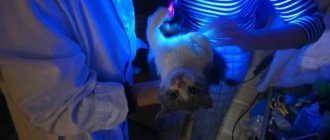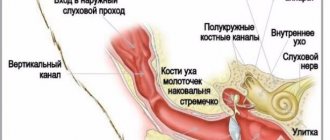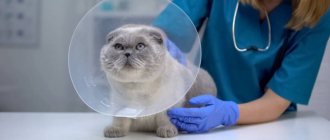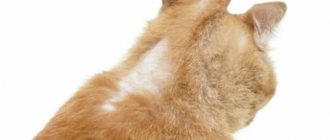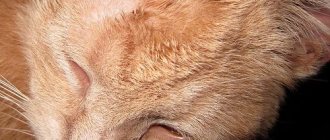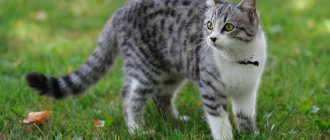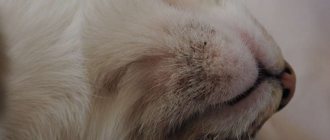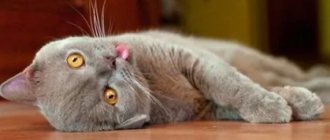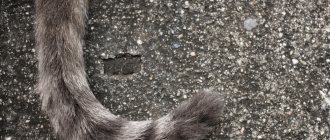Lichen is the common name for dermatophytosis, trichophytosis, microsporia in animals
Ringworm (dermatophytosis, trichophytosis, microsporia) is a fungal skin disease of cats and dogs. The disease is contagious to people and other animals! The disease is caused by fungi of the genus Microsporum, Epidermophyton, Trichophyton . Even with long-term storage in the environment, these mushrooms remain dangerous for a long time due to their spores. The spores can survive in the environment for several months to several years. The incubation period (the period from infection to the onset of skin signs) is from 4 days to 4 weeks.
Preventive actions
To prevent infection of the animal, you should follow the rules regarding prevention.
First of all, it is recommended to limit contact with animals living outside. Owners need to regularly examine their pet's fur and the appearance of its skin.
Ringworm in cats - main signs, symptoms, prevention and treatment of ringworm in cats (105 photos)Pancreatitis in cats: first symptoms, nutritional nuances and treatment options (125 photos and videos)
Subcutaneous mites in cats - first symptoms, treatment options and real photos of examples of parasite damage (110 photos + video)
It is mandatory to clean the living space. The animal's diet must be balanced, with special attention paid to maintaining the immune system.
Clinical signs of lichen in cats and dogs
Spontaneous alopecia areata (baldness), sometimes with a red rim around the periphery of the baldness. The spot may peel off and is rarely accompanied by itching (scratching). Lesions are often located on the face and ears; young and immunocompromised animals are more susceptible to the disease (for example, with hyperadrenocorticism in dogs , diabetes mellitus in cats and dogs, immunodeficiency and feline viral leukemia, cancer).
A characteristic manifestation of lichen on the skin of the back of a Bambino cat.
Persian cats and Yorkshire terriers are at-risk breeds.
Cats can be carriers and sources of infection without showing clinical signs themselves. In long-haired cats, hair may not fall out, for example, in cats of Persian breeds, lichen can occur as single or multiple nodules in the thickness of the skin, felt like plaques under the skin with a diameter of 1-8 cm, with or without ulceration, on the back, sides or neck ( pseudomycetoma ). If you accidentally damage these areas of the skin, systemic mycosis may develop (spread of the fungus throughout the body, including into the internal organs).
In dogs, the fungus Microsporum canis causes a severe inflammatory reaction. Skin lesions look like a kerion (a thickening of any shape that rises above the skin).
One of the manifestations of lichen in dogs is kerion. In this photo there is a round, hairless spot on the upper lip, rising above the surface of the skin.
Diagnosis of lichen in cats and dogs
None of the methods for diagnosing lichen in cats and dogs excludes the disease 100%!
Diagnostic methods:
- Wood's lamp (ultraviolet lamp) - used for quick diagnosis of lichen. Diagnostics are carried out in a dark room. The lamp must first be warmed up for 5-10 minutes. The method is based on the fact that in ultraviolet rays, hairs damaged by M. Canis mushrooms glow emerald. It should be recalled that lichen is caused not only by this fungus; there are others that do not cause an emerald glow. Thus, if the hair does not glow, we cannot rule out ringworm. False-positive glow is also common (due to iodine preparations, dust, lint, skin flakes, food residues).
Microsporia in a kitten. Positive glow of fungus-damaged hairs when examined with a LUM lamp. Emerald glow of fur on a kitten's ears.Microsporia in a kitten. Emerald glow of the hairs on the ears and head of the kitten.
- Microscopy of scrapings/trichoscopy. Examination of hair under a microscope The method consists of studying the structure of the hair under a microscope. As a rule, the affected hair has a destroyed shaft; sometimes spores and fungal hyphae can be clearly seen. The disadvantages of this method are that the affected hair may not be included in the selected material for research.
Trichophytosis in a cat. Microscopy reveals damaged hair structure (hyphae and fungal spores in the hair shaft).Microsporia in a cat. Fungal spores are clearly visible in the destroyed hair shafts (red arrow).
Microsporia in a cat. Fungal spores (circled in red) are visible near the intact hair shaft.
- Cytology/biopsy. Material is taken from the lesion with a thin needle, distributed over the glass, and stained with special dyes (Diff-Quick, Leuco-Diff). This method is more suitable for lesions such as pseudomycetoma in cats or kerion in dogs. Fungal spores can be seen in the stained smear.
- Sowing. The selected material (hairs, skin flakes) is placed on special media for fungal cultures. The method is the most time-consuming (assessing crop growth can take several days, sometimes up to 3 weeks), but has greater reliability of the results obtained than all other methods. The grown colonies must be examined under a microscope to determine the type of fungus.
This is what Microsporum canis colonies look like on special media. They are characterized by a white color and a change in the color of the medium - it turns red as the mushroom colony grows.
Microsporum canis. The fingerprint was taken from Wednesday (see photo above).
- PCR . Polymerase chain reaction is based on the detection of pathogen DNA and identification of the species. The animal's fur is sent to the laboratory for testing. A reliable method if the selected material contains a pathogen.
Treatment of lichen in cats and dogs
In cats, cases of spontaneous recovery have been noted within 12-14 weeks. However, treatment should be carried out to prevent infection of other animals and people, to speed up recovery, and to reduce the spread of spores in the environment. The course of treatment is quite long, can take up to 4 months.
Successful treatment of lichen in cats and dogs is based on 3 areas:
- Systemic treatment . It is necessary to carry out this procedure, since it is mainly the growing hair that is affected; local products cannot penetrate into the hair in any way. For systemic treatment, antifungal agents (itraconazole, fluconazole, terbinafine) are used in tablet form. The course is long and well tolerated by animals. Some products accumulate in the skin and are contained in it for a long time in a therapeutic concentration; such products can be used in a pulse mode (the drug is taken only 2 days a week or every other day).
- Local treatment. It is used to prevent fungal spores from entering the environment and infecting other animals and people. The whole animal must be washed! Treating only the affected areas will not bring any effect, since spores can be found on the entire surface of the body. To wash animals with lichen, use Imaverol, Lime Sulfur, Liverazol, and shampoos with enilconazole. Treatment is carried out 2 times a week, some products do not need to be washed off, the therapeutic effect is achieved when the product dries on the coat and skin. For the best effect, long-haired animals are recommended to have their hair cut short or shaved.
- Environmental treatment . Carried out to destroy spores in the environment. Disinfectants with an antifungal effect are used (Imaverol, Clinafarm suppositories, sodium hypochlorite, 5-10% bleach, 0.2% enilconazole, 2% chlorhexidine). Items and clothes can be washed at 60 degrees in a washing machine, 2-3 cycles.
Evaluation of treatment effectiveness
Evaluation of treatment is carried out by culture on special media, culture is done after the disappearance of clinical signs every 2-3 weeks, until a negative result + 1 more control culture.
Only if there are no clinical signs and the culture is negative can the doctor say that the animal is healthy and not a carrier.
Vaccination is not used to treat or prevent lichen infection in cats and dogs!
Today there are no vaccines that can protect animals from infection, this is due to the fact that the vaccine creates humoral immunity (the production of antibodies in the blood and body fluids), and in the case of lichen, only cellular immunity (special cells in the body that react for antigens).
Reviews
Ringworm in its advanced form is very difficult to treat, but this is not a death sentence and we must definitely fight. The Polivac vaccine did not help my cat, the Itracon capsules did not help, he only developed severe hepatitis and he almost died. Due to the treatment of hepatitis, they temporarily stopped treating lichen, the liver failed and the cat was actually dying, there was no time for lichen. For 3 months, about 25–30% of the cat’s skin was damaged and scratched, everything was covered in bloody wounds and scabs, it was constantly itching. I put on a sweater so that I would comb my hair less. After hepatitis, there was no talk of any medications or ointments; only Imaverol was allowed. After 2 days for 3, I smeared it not on the whole cat, but only on the lesions and around them, and on the doctor’s advice I diluted it not 1:20, as written in the instructions, but first for about a month I diluted it 1:5, then 1:10 . At the beginning of treatment, she was given the immunostimulant Cycloferon in parallel. I was treated for 2.5 months, the first month it generally seemed to me that the lesions were only growing and nothing was helping. After about a month, new lesions stopped appearing and gradually began to heal, the scabs fell off and became overgrown with hair. The fur, of course, was in terrible condition after that, I was pierced with vitamins Gepavi-kel and Tetravit and the cat was transformed before our eyes, now he is a fluffy handsome man. I vacuumed and washed the premises, but didn’t really treat them; it’s simply impossible to treat them properly at home. Don't give up and don't despair, everything will work out for you.
Svetlana
https://forum.ua-vet.com/viewtopic.php?f=23&t=52776
When we were covered with a fungus, Griseofulvin helped us. It may seem too harsh to some, but we didn’t come to him right away either, it’s a pity they didn’t tell us about him earlier, and so we had to feed the entire herd with Griseofulvin. But the results were noticeable after about the first week. Give 1/6 tablet once a day. Those who have not become infected can take it for a week; patients who are sick need a course of 3-4 weeks, even if everything goes away in 1-2. But Fungin is still not worth it for a small kitten, he is very vigorous, the kitten can puke on him and, excuse me, he can vomit... Isolate the small one if possible. Well, wash the apartment with some special means, or just vinegar water.
sanguiss
